![]()
HISTORY OF BINGHAM
STUART TIMES
The Stanhopes
When King James came to the throne in 1603, Bingham had been owned by Sir Thomas Stanhope for over a decade. The Stanhope family, which later became the Earls of Chesterfield owned Bingham until late in the 19th century. Thomas Stanhope lived in Shelford and, like Brian Stapleton a century earlier, he seems to have been a progressive farmer. On the evidence of hedgerows that survive from the 16th century and which mark boundaries that do not appear on the 1586 map, he divided East Meadow (see Figure 3.37) into smaller parts to improve grazing and possibly introduced a three-year rotation of arable and grazing. It is also possible that he divided up the demesne lands along the Fosse Way for the same purpose (see Figure 3.39).
A major change he is probably responsible for is evident from the distribution of Midland Yellow Ware pottery (Figure 3.34). It shows that large parts of the open fields that hitherto had been arable are devoid of any Midland Yellow Ware suggesting that they had been converted to pasture. The complete absence of the Yellow Ware from these areas seems to indicate that the change happened before Midland Yellow Ware was in use in Bingham. This was late in the 16th century around the time Thomas Stanhope acquired the manor and once converted the areas of pasture remained grassland through to the end of the 17th century. The change from arable to pasture possibly reflects changes to the agricultural economy whereby rearing sheep for wool became more profitable than growing grain. It might have been a logical development following on developments already underway while Brian Stapleton owned the manor. Already in 1586 some arable strips in the open fields appear to have been partially pasture or meadow. This was particularly so in East Field, where the largest area of arable was later converted to pasture,
The Civil War
Direct evidence of the Civil War in Bingham is sparse. Bingham was part way between the parliamentary stronghold at Nottingham and Royalist Newark and the presumption is that Bingham, sitting on the intersection of the Fosse Way and a major east-west road must have been visited by troops of both sides at various times. It is believed that the church font was desecrated at about 1650, while the Bingham estate itself became a trophy of war when it was taken out of the hands of the Royalist Earl of Chesterfield for some time.
There are no records of skirmishes or battles over the parish, but there is documentary evidence that Prince Rupert spent part of the night 20/21st March 1644 in Bingham on his way to relieve the Parliamentarian siege of Newark. His army consisted of 3000 infantry and 3000 cavalry. He is said to have occupied a close overlooking Bingham that night. Mobile seventeenth century armies did not camp in tents and 6000 men and horses would have spread themselves over the parish seeking water for themselves and the horses and shelter if the weather was poor. Only the officers are likely to have been billeted in homes.
The only physical evidence of the Civil War is in the form of two cannonballs found in the parish. Neither of them is likely to have been fired in anger over Bingham. One was for a minion cannon, a small mobile cannon with a three-inch bore widely used in the Civil War. The other was for a 4-inch bore demi-culverin, a heavy cannon used as a siege weapon.
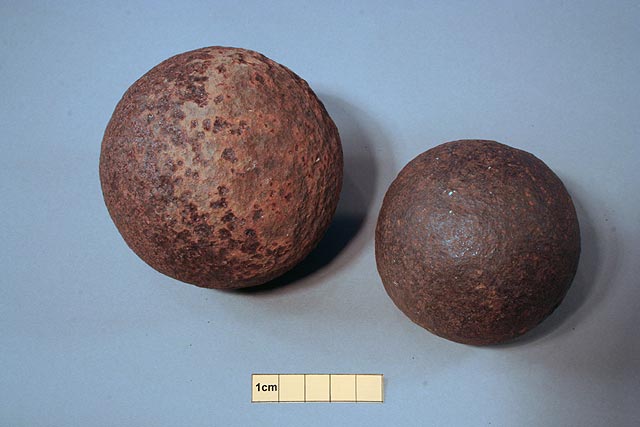
Two cannon balls from the English Civil War. The larger is for a demi-culverin cannon; the smaller for a minion.
A study of the distribution of mid 17th century clay pipes (see Figure 3.43) showed that apart from those on the village dumps most were to be found close to the roads, some of which no longer exist, in the south western part of the parish. This may show that the army approached Bingham using both the A46 and the Tithby Road. The cannonballs were also found close to these roads in this area and it is assumed that it was here that the soldiers probably spent the night. However, troops probably passed through Bingham en route to and from nearby sieges of Shelford Manor and Wiveton Hall in 1646.
Quality of life in the 17th century
Despite the turmoil of the run-up to and the aftermath of the Civil Wars the 17th century saw many lifestyle changes, which are well represented by the pottery, glass, clay pipes and other artefacts that were picked up in the fields.
Glass making was one of the new industries to be established in Nottingham in the 17th century, where both bottles and window glass were manufactured. During this period many timber-framed houses were rebuilt in Nottingham using brick and roofed with pan tiles and they had glazed windows. A single piece of probable 17th century aqua, mottled, flat glass that could have been window glass was found in Bingham and indicates that this trend may have been extended to here. Most of the glass found field walking is dense, thick, green bottle glass, most likely to have been used for wine bottles. Indications of a certain level of affluence among the better off farmers is the discovery of two fragments of multicoloured Venetian glass, though they may even have been from the16th century.
While pewter was still popular among the better off there is a far wider range of uses for pottery than in previous centuries. The characteristic coarse ware used in the kitchen and dairy until near the end of the 17th century is Midland Yellow Ware. The range of vessels inferred from the sherds includes pancheons, jars, handled storage vessels or chamber pots, shallow bowls and candlesticks. They were almost certainly made in Ticknall and are referred to as “white ware” in Leicestershire inventories throughout the 17th century.

Midland Yellow Ware pie dish, 22 cm diameter with handle on one side only. NCN HH-X 1093 Nottingham Brewhouse Yard Museum.

Midland Yellow Ware flat bottomed bowl with handle, 9.5 cm deep, 16cm diameter. NCM 1966-170/67 Nottingham Brewhouse Yard Museum
Midland Black Ware would have been found in the homes of the better off farmers. It often had a shiny black glaze and from the evidence of the sherds found many of the vessels used were cups, rather robustly made tankards, shallow bowls, bottles, jugs and decorative bowls. (see below 1) There are also some black glazed chamber pots (see below 2) and among the kitchen ware are colanders, pipkins, jugs and small, shallow, curved bowls. Although there is an indication that some fine wares were made from Midland Yellow Ware most fine ware was black glazed.
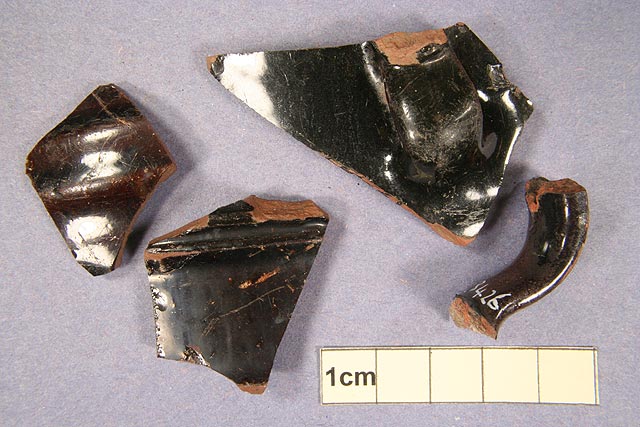
Four sherds of Midland Black Ware found in Bingham. All are from small vessels, probably cups, tankards and small bowls.

Black to dark brown glazed chamber pot, 15cm deep and 20 cm at the rim. This specimen found in an excavation in Nottingham has not been dated, but the fabric strongly resembles the Coarse Black Ware sherds found in Bingham and thought to have a date range from 16th through to 18th centuries. NCM 1953-30 Nottingham Brewhouse Yard Museum.
In the last decades of the 17th century a popular fashion in pottery was slipware. Dotted and slip-trailed decoration, where a slip of liquid clay was applied as piping, required a special dexterity to do well and was probably at its very best in 17th century England when it was particularly favoured during the reign of Charles II. (see below) In Bingham the slip-trailed wares are usually light brown with a white trailed slip creating a yellow finish and nearly all of the sherds were from plates or dishes. A small number of sherds have a white slip coat creating a yellow background, which was decorated with brown dots, cartwheels and loops by using a red-trailed slip. Some of the red ornament was further decorated with white slip dots.
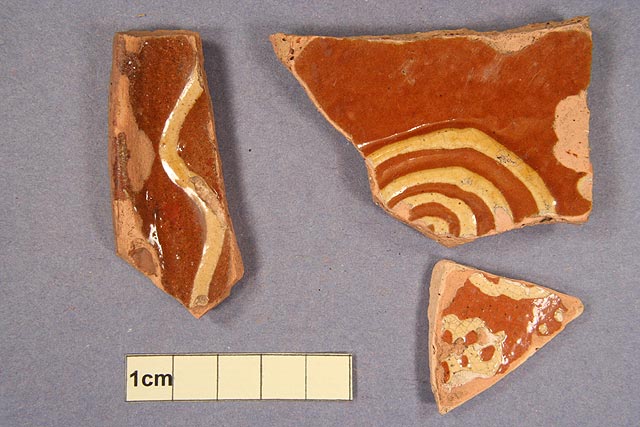
Sherds of slip-trailed plates or dishes found in Bingham. The pink body clay and the pipes white ornament are clearly visible.
Clay smoking pipes
Clay tobacco pipes were being made in England soon after the introduction of tobacco in around1558, but none were found in Bingham that pre-dated 1620. This is a significant date because prior to 1610 tobacco was expensive and not widely smoked, but between 1610 and 1620 the colony of Virginia hugely increased the acreage used for growing tobacco. Prices fell sharply and tobacco became widely available. These early pipes were quite small with a slightly bulbous bowl, an internal diameter a little less than 10 mm and a flat heel. The internal depth of the bowl is about one inch (25 mm). Some of the earliest pipe bowls have a milled ring around the rim, though there are others with a plain rim. The opening of the pipe bowl pointed forward, always making an angle to the stem. The design of clay pipes, however, was not static and with time the size of the bowl increased and the shape changed. The earliest decorated pipe found in Bingham dates from 1660 –1680. It has a mulberry decoration on both sides of the bowl and the flat heal tapers backwards. It was towards the end of the 17th century that makers began to stamp their mark on the bowl. Edward Godfrey, John James and William Sefton, all from Nottingham, made pipes being smoked in Bingham at this time.
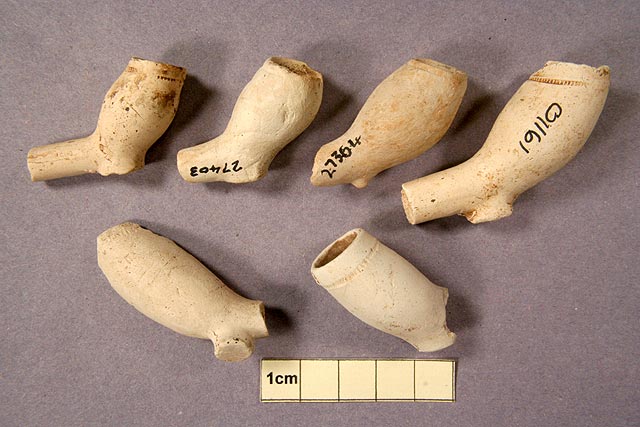
The six bowls here show the progressive change that took place is size and shape through the 17th century. Bowls B and C are both likely to have been used during the Civil War. Most have flat heels, but C has a spur, which came in for the first time during the middle of the 17th century.
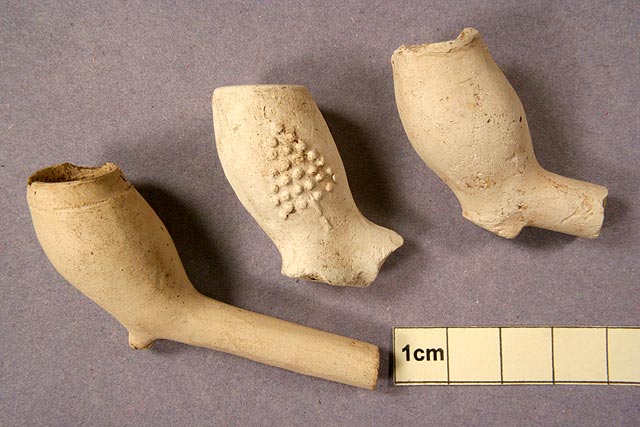
Three bowls from the period 1660-1680 showing contrasting styles. The bowl on the left has a slightly forward pointing spur; the middle pipe has a mulberry bush design and is the earliest bowl with a design found in Bingham; far right retains the flat heel.
Enclosure
Bingham lies within classic Planned Countryside of Eastern England, which is where the land was farmed in large open fields. Although open fields remained until the 19th century in some places, and in Laxton are still there, the process of dividing them up into small individual closes, called enclosure, started in medieval times. There is evidence from field walking in Bingham that there were ditched or hedged boundaries separating arable land from pasture as early as the 12th century (Figure 3.63). This process continued in a piecemeal fashion into the 17th century.
There is no direct evidence for the date of general enclosure in Bingham. The process was a massive undertaking and had a profound social effect on the community. It involved all the open fields being broken up and land reallocated to landowners and tenants in compact hedged blocks in proportion in size to their original holdings (but reduced in area to cover the costs of the process). It would have been carried out by professional land surveyors and often took two or three years to complete.
In Bingham, enclosure would have been done by formal agreement between the landowners. There were two major landowners in Bingham. The Earl of Chesterfield owned most of the parish, but the Porter family had two significant holding together with a large number of freehold strips in the open fields. Other freeholders with smallholdings in the village also had freehold strips in the open fields. We know from the survey of 1776 that most of the farmland had by then been divided into the system of closes that in essence survives today. From about 1750 onwards it became normal for enclosure to be achieved through individual private Acts of Parliament. The absence of an Act of Parliament for Bingham implies that enclosure was before then. The main source is John Throsby’s book, History of Nottinghamshire (1797) in which it is stated about Bingham, “lordship contains about 3000 acres of land inclosed upwards of 100 years.” This would put the date of enclosure at around 1690. The agronomist Robert Lowe writing in1798 lists Bingham as having been enclosed within 20 years in his Appendix VII. It is unlikely that he meant the full, general enclosure, but rather the completion of the enclosure process.
There is support for the late 17th century date in the names of some of the new fields or closes. Both the Chesterfield Estate maps of 1776 and the Bingham Tithe Map of 1841 show many closes bearing the name ‘plotts’ (eg. Toothill Plotts). This is a 17th Century word for an allotment or enclosure and is not found in the 1586 survey. The probate inventory of Thomas Maching, chapman, of Bingham in 1705 mentions livestock in the ‘Flash-plott’ and the ‘Cheese plott alias Marly-pit plott’, suggesting that enclosure had taken place by this date. The Cheese Plott was probably an allocation of pasture set aside on enclosure for the cottagers to graze their dairy cows in compensation for the loss of common pasture; similar ‘cheese plots’ or ‘cottage plots’ are found in other Nottinghamshire villages. It was situated to the south of the Grantham Road just beyond the junction with The Banks.
Further circumstantial evidence derives from the fact that one of the named surveyors for the private enclosure of Balderton parish near Newark in 1692, Thomas Secker, was living at Bingham in at least 1690-2, which may imply that he had been employed on a similar task at Bingham.
It seems likely that not all the common pastures and meadows were enclosed in c.1690, but that for the estate tenants the common land remained available until after 1776, but before 1841, the date of the tithe apportionment.
The process of enclosure changed for good the way in which the land around Bingham was farmed and it released the tenants to manage their holdings to suite the way they wanted to farm. Between 1776 and 1841 many of the large fields were divided into smaller units, probably better to manage the grazing. Several of the field boundaries recorded on both of these maps appear on the 1883 OS map to have been straightened or rationalised in some way. Indeed, the survey of hedgerows carried out by BHTA in 2003 provided abundant evidence that many of the presently existing hedgerows could not have been the ones planted in 1690 and must have been improved. Then, in the 1960s there was wholesale change again when most of the tenants changed from mixed farming to mainly arable. Miles of hedgerow were ripped out to create large fields suitable for efficient arable cultivation.
